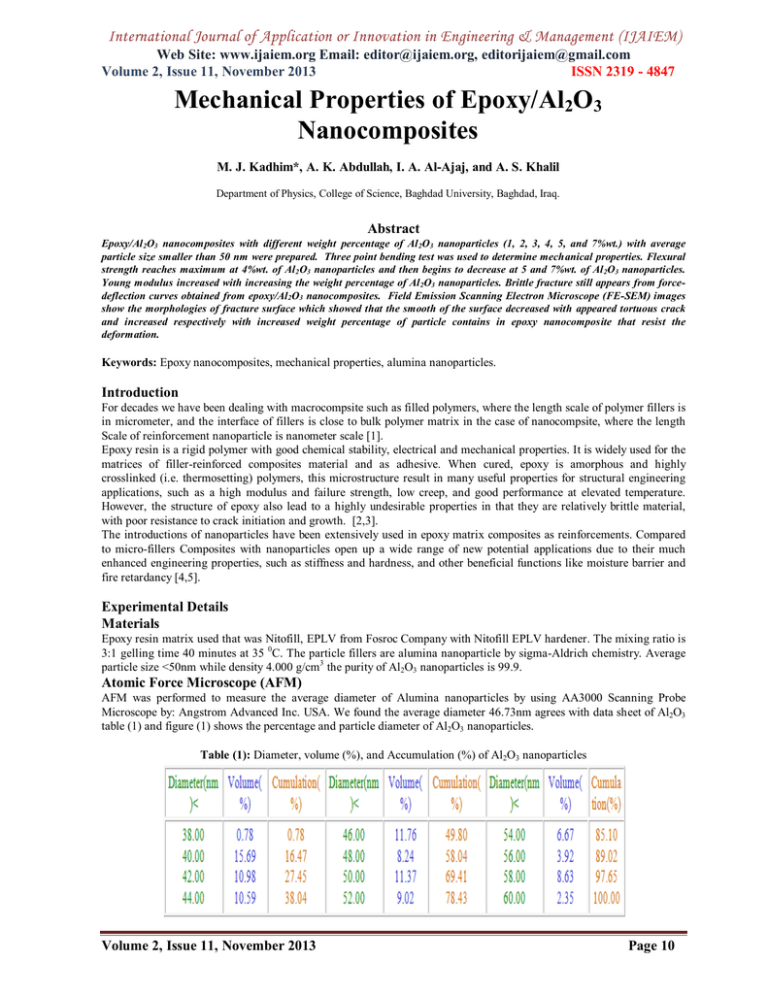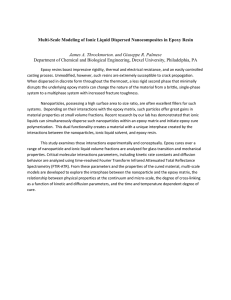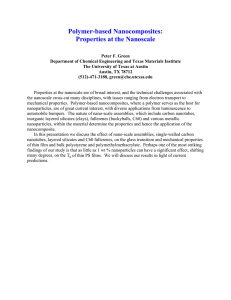International Journal of Application or Innovation in Engineering & Management... Web Site: www.ijaiem.org Email: , Volume 2, Issue 11, November 2013
advertisement

International Journal of Application or Innovation in Engineering & Management (IJAIEM) Web Site: www.ijaiem.org Email: editor@ijaiem.org, editorijaiem@gmail.com Volume 2, Issue 11, November 2013 ISSN 2319 - 4847 Mechanical Properties of Epoxy/Al2O3 Nanocomposites M. J. Kadhim*, A. K. Abdullah, I. A. Al-Ajaj, and A. S. Khalil Department of Physics, College of Science, Baghdad University, Baghdad, Iraq. Abstract Epoxy/Al 2O3 nanocomposites with different weight percentage of Al 2O3 nanoparticles (1, 2, 3, 4, 5, and 7%wt.) with average particle size smaller than 50 nm were prepared. Three point bending test was used to determine mechanical properties. Flexural strength reaches maximum at 4%wt. of Al2 O3 nanoparticles and then begins to decrease at 5 and 7%wt. of Al 2O3 nanoparticles. Young modulus increased with increasing the weight percentage of Al 2O3 nanoparticles. Brittle fracture still appears from forcedeflection curves obtained from epoxy/Al2O3 nanocomposites. Field Emission Scanning Electron Microscope (FE-SEM) images show the morphologies of fracture surface which showed that the smooth of the surface decreased with appeared tortuous crack and increased respectively with increased weight percentage of particle contains in epoxy nanocomposite that resist the deformation. Keywords: Epoxy nanocomposites, mechanical properties, alumina nanoparticles. Introduction For decades we have been dealing with macrocompsite such as filled polymers, where the length scale of polymer fillers is in micrometer, and the interface of fillers is close to bulk polymer matrix in the case of nanocompsite, where the length Scale of reinforcement nanoparticle is nanometer scale [1]. Epoxy resin is a rigid polymer with good chemical stability, electrical and mechanical properties. It is widely used for the matrices of filler-reinforced composites material and as adhesive. When cured, epoxy is amorphous and highly crosslinked (i.e. thermosetting) polymers, this microstructure result in many useful properties for structural engineering applications, such as a high modulus and failure strength, low creep, and good performance at elevated temperature. However, the structure of epoxy also lead to a highly undesirable properties in that they are relatively brittle material, with poor resistance to crack initiation and growth. [2,3]. The introductions of nanoparticles have been extensively used in epoxy matrix composites as reinforcements. Compared to micro-fillers Composites with nanoparticles open up a wide range of new potential applications due to their much enhanced engineering properties, such as stiffness and hardness, and other beneficial functions like moisture barrier and fire retardancy [4,5]. Experimental Details Materials Epoxy resin matrix used that was Nitofill, EPLV from Fosroc Company with Nitofill EPLV hardener. The mixing ratio is 3:1 gelling time 40 minutes at 35 0C. The particle fillers are alumina nanoparticle by sigma-Aldrich chemistry. Average particle size <50nm while density 4.000 g/cm3 the purity of Al2O3 nanoparticles is 99.9. Atomic Force Microscope (AFM) AFM was performed to measure the average diameter of Alumina nanoparticles by using AA3000 Scanning Probe Microscope by: Angstrom Advanced Inc. USA. We found the average diameter 46.73nm agrees with data sheet of Al2O3 table (1) and figure (1) shows the percentage and particle diameter of Al2O3 nanoparticles. Table (1): Diameter, volume (%), and Accumulation (%) of Al2O3 nanoparticles Volume 2, Issue 11, November 2013 Page 10 International Journal of Application or Innovation in Engineering & Management (IJAIEM) Web Site: www.ijaiem.org Email: editor@ijaiem.org, editorijaiem@gmail.com Volume 2, Issue 11, November 2013 ISSN 2319 - 4847 Figure (1): percentage (%) vs. Diameter of Al2O3 nanoparticles B. Preparation of Nanocomposite Samples. There are many techniques which can be used to incorporate the nanoparticles into the polymer matrix. However, in this study we used two preparation methods. The first method without nitrogen flow included: nanoparticles heating in an oven at 1300C to reduce the moisture, and then weighted. Nanoparticles with epoxy resin were mixed by magnetic stirrer at 700 rpm 600C for 30 minutes, used the homogenizer devices 3 min for separate nanoparticles and broken up the agglomeration of its to improve compatibility of the filler with host material. The hardener was mixed for 10 minutes by magnetic stirrer, using homogenizer device for 3 min again to get better homogeneity. During the preparation, air bubbles can get trapped in the material, especially during the mixing processes. To negate the influence of air bubbles on mechanical and dielectrical measurements, degassing of the epoxy/Al2O3 nanocomposites required so we used vacuum system (10-2 bar) as shown in figure (2) to remove the bubbles before molding the composites. We found the shape of specimen for concentration 0.1% wt. of Al 2O3 nanoparticles is not perfect because it is contains some intended matter that is come from atmosphere as shown in figure (3a). Figure (2) Vacuum system used to remove the bubbles from the samples The second method with nitrogen flow included: after heating the nanoparticles in an oven as in the first method, the nanoparticles are weighted and manually mixed with epoxy resin under gloves in nitrogen atmosphere which is shown in figure (4). Then followed the same procedure of the first method, we found the shape of specimen for concentration 0.1% of Al2O3 nanoparticles is very perfect and do not contain on any intended matter [5,6] as shown in figure (3b). Figure (3) shape of specimen for methods a) without nitrogen flow included b) with nitrogen flow included Volume 2, Issue 11, November 2013 Page 11 International Journal of Application or Innovation in Engineering & Management (IJAIEM) Web Site: www.ijaiem.org Email: editor@ijaiem.org, editorijaiem@gmail.com Volume 2, Issue 11, November 2013 ISSN 2319 - 4847 Figure (4) Gloves box (handmade by researcher) The second preparation method is preferred because it is not very complicated from laboratory processing point of view, commercially available polymers and particles could be mixed with ease to prepare a composite, and it's not contain on air bubbles, dust or other unintended matter in polymer matrix can act as defects, which in turn can significantly influence on the mechanical and dielectrical properties of epoxy/Al2 O3 nanocomposites So, we used the final preparation method for preparation the specimens, then tested it. Three Point Bending Test Three point bending test was carried out to test epoxy and epoxy nanocomposites by using Instron 1122 with t510kN full scale load capacity. The force (load) was applied on the middle of specimen supported by two spans. The test was with cross head speed (0.5mm/min). The final samples shape prepared for mechanical test are identical to the specification of ASTM (D790) as in figure 5. L = 80 mm h=4 Ls = 64 mm mm W = 10 mm Figure (5). Epoxy nanocomposite specimen shape for mechanical test, where (h) is specimen thickness, ( L ) is specimen length, (w) is specimen width and (Ls) as support span. Field Emission Scanning Electron Microscopes (FE-SEM) Field Emission Scanning Electron Microscope (FE-SEM) technique was used to image the fracture surface (image range calibration of 15µm). The images of scanning show the representative scanning electron microscope (SEM), the images were captured by using Hitachi S-4160 FE-SEM device. Results and discussion Three point bending test of EP/Al2O3 Nanocomposites Force-deflection curves EP/Al2O3 nano-composites with 1, 2, 3, 4, 5, and7%wt. percentage were tested by three point bending test are shown in figure (6). Flexural strength (σ) values were determined by using the following equation. σ = 3PL/(2bd2)……………(1) Where L: Length of specimen, P: Fracture load obtained from bending test, d: width of specimen, b: depth of specimen. And the young modulus is determined from following equation. E=mL3/4bd3…………… (2) Where (m) is the slope of the straight-line portion of force-deflection curve [11,7]. The resultants of flexural strength of EP/Al 2O3 Nanocomposites in table (2) and figure (7) and shows the variation of flexural strength of EP/Al2 O3 nanocomposite vs. Al2O3 nanoparticle weight percentage. The results of flexural strength have most probably highest value at 4% wt. maximum increment obviously appeared in this behavior in which agree with Wetzel et al.[3]. At higher addition of Al2O3 nanoparticle (5 and 7% wt. of Al2 O3 nanoparticles) , flexural strengths of EP/Al2O3 nanocomposite decrease with increasing weight percentage of Al2O3 nanoparticle but the results of flexural strength still higher than that of epoxy this behavior is in good agreement with Abd [7]. The effect of several factors explain this Volume 2, Issue 11, November 2013 Page 12 International Journal of Application or Innovation in Engineering & Management (IJAIEM) Web Site: www.ijaiem.org Email: editor@ijaiem.org, editorijaiem@gmail.com Volume 2, Issue 11, November 2013 ISSN 2319 - 4847 behavior in EP/Al2O3 nanocomposites, The existence of Al2O3 nanoparticles in the epoxy matrix leads to several changes in the epoxy chains and their structures, where good distribution and dispersion of nanoparticles in epoxy matrix lead to reduction the mobility of the epoxy chains due to formation high immobility nanolayer around each nanoparticles, while the matrix chains (epoxy chains not bonded to nanoparticles) bonded to that nanolayer constrained the non-contact matrix chains, So the network of nanoparticles reduce the overall mobility of the nanocomposites system. The effect of several factors explain this behavior in EP/Al2O3 nanocomposites, The existence of Al2O3 nanoparticles in the epoxy matrix leads to several changes in the epoxy chains and their structures, where good distribution and dispersion of nanoparticles in epoxy matrix lead to reduction the mobility of the epoxy chains due to formation high immobility nanolayer around each nanoparticles, while the matrix chains (epoxy chains not bonded to nanoparticles) bonded to that nanolayer constrained the non-contact matrix chains, so the network of nanoparticles reduce the overall mobility of the nanocomposites system. The addition of Al2O3 nanoparticles lead to decrease in space distance (reduce free space distance between epoxy chains) where the addition of Al2O3 nanoparticles which are polar particles [7], lead to filling free space between chains and attract resin molecules and hence epoxy chains during curing processes creating more complicated network chains. Also Al2 O3 nanoparticles creating hydrogen bonding between chains and particles, which is explain to another section, lead to increase constraint between; particles/polymer chains, and polymer chains itself leading chains to bear extra-forces, The behavior of decreasing fracture strength due to nanoparticles agglomerations lead to increase the space distance (free volume space) between epoxy chains, so, increasing of free volume space which leads epoxy chains to bear lesser-forces so the fracture strength begin to decrease. Figure (6). Force-deflection curves for epoxy and EP/ Al2O3 nanocomposites with 1, 2, 3, 4, 5 and 7%wt. of Al 2O3 nanoparticles . Table (2) Maximum fracture force, maximum deflection, flexural strength, Young modulus and fracture toughness of epoxy and EP/ Al2O3 nanocomposites. Volume 2, Issue 11, November 2013 Page 13 International Journal of Application or Innovation in Engineering & Management (IJAIEM) Web Site: www.ijaiem.org Email: editor@ijaiem.org, editorijaiem@gmail.com Volume 2, Issue 11, November 2013 ISSN 2319 - 4847 100 90 Flexural srength(MPa) 80 70 60 50 40 30 20 10 0 0% 1% 2% 3% 4% 5% 6% 7% 8% wt% Figure (7). Flexural strength vs. Al2O3 weight percentage of EP/Al2O3 nanocomposites Young modulus increased with increasing weight percentage of Al2O3 nanoparticles of EP/Al2O3 nanocomposites. At 7% wt. of Alumina nanoparticles Young modulus reach maximum increment. In general all the results obtained after the addition of Al2O3 nanoparticles to epoxy were higher than that of epoxy specifically at low weight percentage of Alumina nanoparticles; this behavior of EP/Al2O3 nanocomposites is in good agreement with the behavior obtained by Wang et al. [12] and Johnsen et al. [13]. The increase of weight percentage of Al2O3 nanoparticles leads to increase of constraint of epoxy chains where chains deflections and mobility will be reduced, so all the results of Young modulus were higher than that of epoxy. Figure (8) Young modulus vs. Al2O3 nanoparticles weight percentage of EP/Al2O3 Nanocomposites. Scanning Electron Microscope (SEM) Images of EP/Al2O3 Nanocomposites Topography of Fractured Surface Figure (9a,9b) the fracture surface for neat epoxy and 1%wt. of Al 2O3 nanoparticles respectively displayed a smooth surface, indicating brittle fracture the line crack appear on the surface which refer by dash arrow In figure (9c) and (9d) the smooth of the surfaces decreased slowly with appeared tortuous crack. In the figures (9e), (9f), and (9g) the tortuous crack increased respectively with increasing particle contains that resisted the deformation and crack propagation. The Al2O3 nanoparticles are embedded in epoxy resin matrix, Hence, the primary crack might detour around the Al2O3 nanoparticles or the crack tips are blunted by these nanoparticles. Conclusion 1- Al2O3 nanoparticles enhanced mechanical properties (young modulus and flexure strength) of epoxy matrix with increasing weight percentage of Al2O3 nanoparticles. Flexure strength of epoxy/Al2O3 nanocomposites was enhanced maximum 42% at 4%wt. of Al2 O3 comparing with unfilled epoxy nanoparticles and young modulus still increased with increasing weight percentage of Al2O3 nanoparticles. The young modulus enhanced maximum 187% at 7%wt. of Al2O3 nanopartilces Volume 2, Issue 11, November 2013 Page 14 International Journal of Application or Innovation in Engineering & Management (IJAIEM) Web Site: www.ijaiem.org Email: editor@ijaiem.org, editorijaiem@gmail.com Volume 2, Issue 11, November 2013 ISSN 2319 - 4847 2- Scanning electron microscope (SEM) showed the Al2O3 nanoparticle decrease the smooth surface and increasing the tortuous crack of epoxy/Al2O3 nanocomposites that result from resist of nanoparticle to the deformation and crack propagation. Figure (9) SEM image for fracture surface of a)Pure epoxy. b)Epoxy/ 1%wt. of Al2O3 nanocomposites. c)Epoxy/ 2%wt. of Al2O3 nanocomposites. d)Epoxy/3%wt. of Al2 O3 nanocomposites. e)Epoxy/4%wt. of Al2O3 nanocomposites. f)Epoxy/5%wt. of Al2O3 nanocomposites. g)Epoxy/7%wt. of Al2 O3 nanocomposites Reference [1.] J. H. Koo, Polymer Nanocomposite, Processing, Characterization and Application, Mc. GrawHill companies, USA, 2006. [2.] Johnsen B., Mohammed R., Taylor A. , Sprenger S., " Toughening Mechanisms of Particles Modified Epoxy Polymers", Journal of Polymer, Vol. 48, 530-41,2007. [3.] Wetzel B., Rsso P., Haupert F., Friedrich K., "Epoxy Nanocomposites-Fracture and Toughening Mechanism", Journal Engineering Fracture Mechanism Vol.73, 2375-98,2006. [4.] Ragosta G., Abbate M., Musto P., Scarinzi G, Mascia L., "Epoxy-Silica Particulate Nanocomposites: Chemical Interactions, Reinforcement and Fracture Toughness", Journal of Polymer Vol. 46, 10506-16,2005. [5.] P. M. Ajayan, L. S. Schadler, P. V. Braum, "Thermally Conducting Aluminum Nitride Polymer-Matrix Composites", Journal of Composites: Part A, Vol. 32, 1749-1757,2011. [6.] T. H. Hsieh, A. J. kinlock, K. Masania, A. C. Taylor, and S. Sprenger, "The Mechanisms and Mechanics of Toughening of Epoxy Polymers with Silica Nanoparticle", Elsevier, Journal of polymer, vol. 516284-6294,2010. [7.] M. M. Abd, "(Nano_Micro) Particles/Epoxy Composites", Ph. D. Thesis, Department of Physics, Baghdad University, Iraq, 2012. [8.] S. Singha and M. J. Thomas, "Dielectric Properties of Epoxy-Al2O3 Nanocomposite System for Packing Application", Journal of IEEE Transactions on Components and Packing Technology Vol. 33, No.2,pp 1521-3331, 2009. [9.] S. Singha and M. J. Thomas, "Dielectric Properties of Epoxy Nanocomposite", Journal of IEEE Transactions on Components and Packing Technology, Vol. 15, No. 1,2008. Volume 2, Issue 11, November 2013 Page 15 International Journal of Application or Innovation in Engineering & Management (IJAIEM) Web Site: www.ijaiem.org Email: editor@ijaiem.org, editorijaiem@gmail.com Volume 2, Issue 11, November 2013 ISSN 2319 - 4847 [10.] B. Bittmann, F. Haupert , and A. K. Schlarb, "Ultrasonic Dispersion of Inorganic Nanoparticles in Epoxy Resin", Elsiever, Journal of Ultrasonic Sonochemistry Vol. 16, 622-628, 2009. [11.] D. Gross and T. Seeling, Fracture Mechanics with An Introduction to Micromechanics, Springer-Verlag Berline Heidelberg, USA, 2006. [12.] K. wang,C. L. Chen, J. Wu, M. L. Toh, C. He, and A. F. Yee,"Epoxy Nanocomposites with Highly Exfoliated Clay: Mechanical Properties and Fracture Mechanisms," American Chemical Society, Macromolecules, Vol.38, 788-800, 2005. [13.] B. B. Johnsen, A. J. Kinlock, R. D. Mohammed, A.C. Taylor, and S. Sprenger, " Toughening Mechanisms of Nanoparticle-Modified Epoxy Polymers", Elsevier, Polymer Vol. 48, 530-541(2007). Volume 2, Issue 11, November 2013 Page 16




